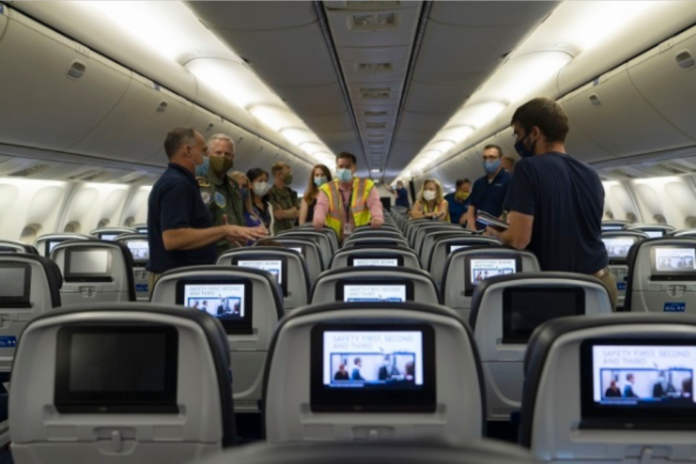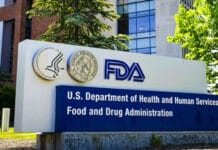The risk of COVID-19 exposure on board an airplane “is very low,” according to a Department of Defense study released last week.
The study was conducted in late August over a period of eight days in partnership with Boeing and United Airlines. More than 300 tests were performed across inflight, simulated inflight, and on-the-ground scenarios.
According to a Department of Defense press release, mannequins with and without face masks sat in various seats on the aircraft “while fluorescent tracer particles were released at intervals of two seconds to simulate breathing for a minute during ground and inflight tests.”
“Real-time fluorescent particle sensors were placed throughout the aircraft at the breathing zone of passengers to measure concentration over time,” said the release. “The test revealed that the released aerosol was rapidly diluted by the high air exchange rates observed in the airframes.”
The study found that the aerosol tracer particles remained detectable within the cabin for an average of less than six minutes. A typical American home, for comparison, requires about 90 minutes to clear the same types of particles from the air, the release said.
“The high air exchange coupled with high efficiency particulate air (HEPA) filtration of all recirculated air, means a commercial aircraft’s air supply system provides protection greater than the design standards for a patient isolation room or a hospital operating room,” it added.
Cmdr. Joe Pope, the U.S. Transportation Command’s liaison for the study, said the test had some limitations because it only considered a single infected passenger and didn’t gather data on passenger movement, but called the results “encouraging.”
“For both the 777 and 767 airframes, the calculations show about 54 flight hours are required for cumulative inhalation of an assumed infectious dose,” he said.
United Airlines told ABC News that there is a 0.003% chance that “particles from a passenger can enter the passenger’s breathing space who is sitting beside them” when wearing masks.
“99.99% of those particles left the interior of the aircraft within six minutes,” United Airlines Chief Communications Officer Josh Earnest told ABC News, calling the risk of COVID-19 exposure on board an aircraft “virtually nonexistent.”
“It indicates that being on board an aircraft is the safest indoor public space, because of the unique configuration inside an aircraft that includes aggressive ventilation, lots of airflow,” he added.
Meanwhile, research from the International Air Transport Association (IATA) shows that just 44 cases of inflight COVID-19 transmission have been reported out of roughly 1.2 billion passengers.
“With only 44 identified potential cases of flight-related transmission among 1.2 billion travelers, that’s one case for every 27 million travelers. We recognize that this may be an underestimate but even if 90% of the cases were un-reported, it would be one case for every 2.7 million travelers,” said Dr. David Powell, IATA’s medical advisor.
Alexandre de Juniac, CEO of IATA, said the risk of contracting the virus on an aircraft “appears to be in the same category as being struck by lightning.”
Earlier this month, Minnesota’s three Republican congressmen — Reps. Pete Stauber, Jim Hagedorn and Tom Emmer — faced an onslaught of negative media coverage because they flew home after being exposed to the virus. DFL Chairman Ken Martin criticized their “stupidity and disregard.”

















